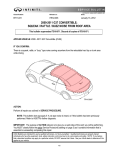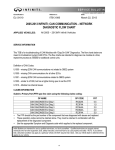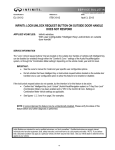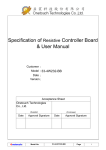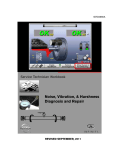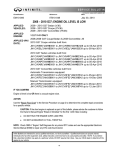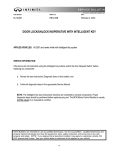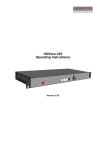Download ITB13-058 - InfinitiG37.com
Transcript
Classification : Reference: Dat e: BT13-016 ITB13-058 December 19, 2013 2009-2013 G37 CONVERTIBLE; SQUEAK / RATTLE / BUZZ NOISE FROM ROOF AND TRUNK AREAS This bulletin supersedes ITB10-071, ITB11-035, ITB12-003, and ITB13-032. APPLIED VEHICLE: 2009 - 2013 G37 Convertible (HV36) IF YOU CONFIRM: There is a squeak, rattle, “buzz”, or rubbing type noise coming from the retractable hard top or trunk areas while driving. • See page 4 and 5 for specific locations and types of noises. ACTION: Refer to the Repair Overview on page 4 and 5. IMPORTANT: The purpose of ACTION (above) is to give you a quick idea of the work you will be performing. You MUST closely follow the entire Repair Overview as it contains information that is essential to successfully completing this repair. Infiniti Bulletins are intended for use by qualified technicians, not 'do-it-yourselfers'. Qualified technicians are properly trained individuals who have the equipment, tools, safety instruction, and know-how to do a job properly and safely. NOTE: If you believe that a described condition may apply to a particular vehicle, DO NOT assume that it does. See your Infiniti dealer to determine if this applies to your vehicle. 1/35 PARTS INFORMATION (a) (b) (c) (d) (e) (f) (g) DESCRIPTION PART NUMBER QTY Lock Assy-Folding Roof 97096-JJ50B 1 Repair Procedure A Tape J-50397-15 (a) (b) PAD (felt cloth and tape kit) 97085-JJ52D 1 (c) Repair Procedure C O-RING 970D3-JJ50A 2 (d) Pin - Roof Center, LH 73159-JJ50C 1 Repair Procedure D Pin - Roof Center, RH 73158-JJ50C 1 ® Repair Procedure E DuPont Krytox Lubricant – GPL-105 82306-5Z000 (e) PAD (felt cloth and tape kit) 97085-JJ52D 1 (f) Repair Procedure F MALE ASSY – DOVETAIL 844A7-JJ50B (g) Available in Squeak & Rattle Kit #J-50397. One part will repair more than one vehicle. If needed. Only the 1 mm sheet is used. This part will repair more than one vehicle. If needed. Order this product from your PDC. One container per vehicle. There are three sheets of felt cloth in three different thicknesses. Use the chart on page 33 to determine the location of each thickness of felt cloth. All pieces will need to be cut to size. Up to two pieces, as needed. 2/35 ITB13-058 CLAIMS INFORMATION For procedures A – E be sure to claim on the same repair line Repair Procedure A: Submit a Primary Part (PP) type line claim using the following claims coding: DESCRIPTION PFP OP CODE SYM DIAG Replace Latch 73159-JJ50B SA32AA ZL 46 (1) Reference the current Infiniti Warranty Flat Rate Manual and use the indicated FRT. FRT (1) Repair Procedure B: Submit a Primary Part (PP) type line claim using the following claims coding: DESCRIPTION PFP OP CODE SYM Apply Grease 73159-JJ50B SX10AA ZL DIAG 46 FRT 0.3 DIAG FRT 46 0.3 DIAG FRT 46 0.4 DIAG 46 FRT 0.3 Repair Procedure C: Submit a Primary Part (PP) type line claim using the following claims coding: DESCRIPTION PFP OP CODE SYM Perform Ball Joint and Socket Align Adjustment 73159-JJ50B SX06AA ZL Repair Procedure D: Submit a Primary Part (PP) type line claim using the following claims coding: DESCRIPTION PFP OP CODE SYM Remove Shims 73159-JJ50B SX11AA ZL Repair Procedure E: Submit a Primary Part (PP) type line claim using the following claims coding: DESCRIPTION PFP OP CODE SYM Clean All Weather Strips 73159-JJ50B SX07AA ZL Only Claim Procedure F on a separate repair line Repair Procedure F Submit a Primary Part (PP) type line claim using the following claims coding: DESCRIPTION PFP OP CODE SYM DIA FRT Repair Rear Roof 97160-JJ50A SX08AA ZL 46 5.6 3/35 ITB13-058 SERVICE PROCEDURE Repair Overview Use the following pictures on the next two pages to determine which repairs to perform. # 1) Pop type noise; perform Repair Procedure A starting on page 6. # 2) Creak type noise; perform Repair Procedure A starting on page 6. # 3) Rattle type noise; perform Repair Procedure B starting on page 8. # 4) Ticking type noise; perform Repair Procedure C starting on page 9. # 5) Rear roof panel movement; perform Repair Procedure D starting on page 11. • A ticking and/or rattle type noise may also be heard along with rear roof panel movement. For # 6 and # 7, go to the next page. NOTES: Perform all repairs in a clean work environment. Make sure your hands/gloves are clean. Use fender covers when leaning over the sides of the vehicle. Use protective covering as needed if and when positioned inside the vehicle. Rear roof panel 1 1 (with rear window glass) 3 2 4 3 4 5 Front roof panel Center roof panel Figure 1 4/35 ITB13-058 # 6) Rubbing/creak type noise; perform Repair Procedure E starting on page 13. 6 Figure 2 # 7) Any squeak, rattle, or “buzz” type noise is heard in the shaded area below; perform Repair Procedure F (starting on page 15) when: # 1-6 do not apply OR One or more of # 1-6 have been performed, the remainder of # 1-6 do not apply, and other noises are still heard in the shaded area below. 7 Figure 3 5/35 ITB13-058 Repair Procedure A Perform this repair for one or both of the following noises: • A “pop” type noise in heard in the sun visor area(s) when the vehicle is turning and/or the body flexes. • A “creak” type noise is heard in the center of the front roof garnish when the roof is warm, and driving over bumps. Front roof garnish Figure 1a 1. Replace the roof lock assembly (see PARTS INFORMATION on page 2). • Refer to the K BODY EXTERIOR, DOORS, ROOF & VEHICLE SECURITY > RF Roof section of the Electronic Service Manual (ESM). 2. Before installing, add tape to the roof latch motor where noted on the next page. • Inspect the condition of the felt tape on the front roof garnish’s clips. 6/35 ITB13-058 Tape – cut three 20 x 25 mm pieces Poke a hole through each piece of tape Roof lock assembly Figure 2a Make sure 10 x 50 x 1 mm pieces of felt tape are in place and not damaged Figure 3a Figure 4a: Front roof garnish 7/35 ITB13-058 Repair Procedure B Perform this repair when a rattle type noise is heard on either side between the front and center roof panels when driving over large bumps or potholes. 1. Partly open the retractable hard top (or roof) as shown in Figure 1b. CAUTION: When left in a partially open position, the roof could slowly drop which may cause roof damage. Figure 1b Front roof panel 2. Locate the slider bars between the front and center roof panels on both sides of the roof (see Figure 2b). Slider bar 3. Apply a thin coat of heavy bearing grease or equivalent with a cotton swab or small brush on both slider bars where shown in Figure 3b and 4b. CAUTION: Be careful not to apply an excess amount of grease. It may eventually get on the headlining, causing a stain. Figure 2b Apply grease on slider bar inner edge ONLY Apply grease on upper edge ONLY Figure 3b Figure 4b 8/35 ITB13-058 Repair Procedure C Perform this repair when a ticking type noise is heard around the upper corners of the rear roof panel when driving. NOTE: The rear roof panel includes the rear window glass. Rear roof panel 1. Partly open the roof as shown in Figure 1c. CAUTION: When left in a partially open position, the roof could slowly drop which may cause roof damage. Center roof panel Figure 1c 2. Check both O-rings for impressions. • There is one (1) O-ring at each rear corner of the center roof panel, mounted on center roof panel pins as shown in Figure 2c. Center roof panel pin O-ring Figure 2c 9/35 ITB13-058 3. If impressions are found on either O-ring (see example in Figure 3c): a. Replace both roof panel pins (or pins) if they have not been previously replaced with the ones listed in PARTS INFORMATION (see Procedure D for pin replacement). OR b. If the pins were previously replaced with the ones listed in PARTS INFORMATION, replace the O-rings only. NOTE: Pins come with O-rings, and the O-rings are available separately (see PARTS INFORMATION). Impressions on O-ring Roof panel pin Figure 3c Figure 4c 3. Next, loosen the Torx screws (size T-30) for both rear roof panel retainers. See Figure 5c. • • The retainers are located at both front corners of the rear roof panel. Loosen the retainers enough so they move around easily by hand, but not on their own. Retainer Rear roof panel Figure 5c 4. Fully close the roof. • This will allow the retainers to align with the pins. 5. Open the roof, and then tighten the retainer’s Torx screws. • Torx screws torque: 9.5 N•m (0.97 kg-m, 84 in lb) 10/35 ITB13-058 Repair Procedure D Perform this repair when the rear roof panel moves side-to-side when driving over bumps. • A ticking and/or rattle type noise may be heard during this issue. Rear roof panel 1. Partly open the roof as shown in Figure 1d. CAUTION: When left in a partially open position, the roof could slowly drop which may cause roof damage. Figure 1d 2. Loosen the two Torx screws of both roller hooks, and then remove the shims behind them. • Rear roof panel There are two roller hooks, one on each side of the rear roof panel. • Keep the roller hooks in their original positions as they were before loosening when tightening their Torx screws. • If needed, mark the roller hooks’ positions prior to loosening with a suitable marker that can be cleaned off after this repair. Roller hook CAUTION: If the roller hooks do not keep their original positions, they may not latch properly which may cause damage. Figure 2d Shim 3. After removing the shims, tighten the roller hooks’ Torx screws. • Torx screws torque: 8.5-10.5 N•m (0.871.07 kg-m, 75.2- 92.9 in lb) • Clean off any markings. CAUTION: If the roller hooks are not secured in their original positions, they may not latch properly which may cause damage. Figure 3d 11/35 ITB13-058 4. Replace both roof panel pins (or pins). • Both pins can be accessed by reaching inside the headlining where shown in Figure 4d. • Figure 5d shows the headlining removed for pin location only. The headlining does not need to be removed to access the pins. Access pins from here… …and here Figure 4d Figure 5d Figure 6d 12/35 ITB13-058 Repair Procedure E Perform this repair when a rubbing or creaking type noise is heard from any section of any roof seal while driving. 1. Partly open the roof as shown in Figure 1e. CAUTION: When left in a partially open position, the roof could slowly drop which may cause roof damage. Figure 1e 2. Using a damp cloth, clean the contact surfaces of all roof related weatherstrips (see Figure 2e). Figure 2e • Also clean the area of the seal (where circled in Figure 2e and 3e) on both sides of the vehicle. Figure 3e 13/35 ITB13-058 3. Using your finger, apply a thin coat of DuPont Krytox® Lubricant on all cleaned weatherstrip contact surfaces. • DuPont Krytox® Lubricant is available from your local PDC. See PARTS INFORMATION on page 2. • Make sure to apply lubricant on both surfaces of seals with two (2) contact surfaces. See Figure 4e for example. • For cleanliness, it is recommended to use latex or similar type gloves. Figure 4e Lubricant 14/35 ITB13-058 Repair Procedure F Perform this repair procedure when: • Any squeak, rattle, or “buzz” type noise is heard in the roof area AND • Repair Procedures A-E do not apply OR • One or more of Repair Procedures A-E have been performed, the remainder of Repair Procedures A-E do not apply, and other noises are still heard in the roof area. For tape and felt identification and location, refer to page 32-34. For parts needed, see PARTS INFORMATION on page 2. 1. Remove the rear roof lower garnish with a suitable pry tool. Rear roof lower garnish Parcel shelf finisher board Rear seatback Figure 1f 2. Cut two 10 mm x 100 mm pieces of felt cloth from the 1 mm sheet, and then install where shown in Figure 2f. 3. Break off the locator pin with suitable pliers (see Figure 2f). Felt cloth Felt cloth Locator pin Figure 2f 4. Cut six 10 x 50 mm pieces from the 1 mm sheet, and apply to the clips as shown in Figure 3f, and where circled in Figure 2f. Figure 3f 15/35 ITB13-058 5. Next, position the roof as shown in Figure 4f. CAUTION: When left in a partially open position, the roof could slowly drop which may cause roof damage. 6. Remove the rear roof upper garnish with a suitable plastic pry tool. Rear roof upper garnish Figure 4f 7. Break off flush both locator pins. See Figure 6f, and arrows in Figure 5f. Back side Figure 5f 8. Remove any existing felt cloth from all clips. 9. Cut four 50 mm pieces from the tape roll, and then apply on the clips. See Figure 7f, and where circled in Figure 5f. Break off Apply felt cloth Figure 6f Figure 7f 16/35 ITB13-058 10. Next, remove the front roof garnish with a suitable pry tool. Front roof garnish Figure 8f 11. Apply felt cloth (from the tape roll) along the white dotted line in Figure 9f. Front roof garnish, back side Figure 9f • Figure 10f shows side view (cutaway) of felt cloth position. Felt cloth Front roof garnish base Trim Figure 10f 17/35 ITB13-058 12. If felt cloth is already applied as shown in Figure 11f, skip to Step 15. • If not, go to the next step. Figure 11f Figure 12f 13. Remove any felt cloth found at the sides of the clips (see Figure 13f). Remove Figure 13f 14. Cut seven 10 mm x 50 mm pieces from the 1 mm sheet, and apply to the clips as shown in Figure 11f and 12f. 18/35 ITB13-058 15. If felt cloth is already applied as shown in Figure 14f, skip to Step 16. • If not, go to the next step. 15a. Apply felt cloth to both plates where shown in Figure 14f. Figure 13f • • 5 Cut two 50 mm long pieces of felt cloth from the tape roll and wrap one at location 1 on each plate (see Figure 14f). Cut two 10 mm x 20 mm pieces from the 3 mm felt cloth sheet, and then apply one at location 2 on each plate (see Figure 14f). 1 2 Figure 14f 19/35 ITB13-058 16. Next, drop down the headlining and lay out on the rear back seat to access the rear rib (see Figure 15f). • Refer to the K BODY EXTERIOR, DOORS, ROOF & VEHICLE SECURITY > RF ROOF section of the ESM as needed. • Do not entirely remove the headlining. Leave the tether cords fastened. NOTE: The rear rib comes attached to the headlining. It is shown separate in Figure 16f for easier viewing. Rear rib Headlining dropped Figure 15f 1 Rear rib Tape f Headlining Rear rib Four pieces of 20 mm x 300 mm x 2 mm felt cloth Center position Figure 16f 17. Remove any existing pieces of felt cloth where outlined in blue in Figure 16f. 18. Cut four 20 mm x 300 mm pieces (approximate in length) from the 2 mm sheet. 19. Apply the cut pieces across the length of the rear rib where outlined in blue in Figure 16f. • Start and finish the application from edge to edge as shown in Figure 17f. 20/35 ITB13-058 20. Cut five 30 mm x 35 mm pieces from the 1 mm sheet. 21. Fold in half the longer length of each piece, and then cut a hole at the middle of the fold: 3 mm deep by 5 mm wide (see Figure 18f). 3 mm 5 mm Figure 18f 22. Apply these pieces where shown in Figure 19f and 20f. Figure 19f Figure 20f 21/35 ITB13-058 23. Remove any existing pieces of clear tape from the edge of the rear rib (under blue outline). See Figure 21f. • It is ok to leave the adhesive residue from any removed tape on the rib. 24. Cut pieces from the tape roll, and then apply on the edge where outlined in blue and black (see Figure 21f and 22f). • For easier application, cut the felt cloth in sections. Figure 21f Figure 22f (side view) 22/35 ITB13-058 25. Remove any existing pieces of felt cloth from on and around the clips. Locator pin Clips Figure 23f 26. Cut four 10 mm x 50 mm pieces from the 1 mm sheet, and then apply one to each clip as shown in Figure 24f, and where pointed out in Figure 23f. Apply felt cloth here Clip Figure 24f 27. Break off the locator pin flush, and then apply a piece of felt cloth tape where broken off (see Figure 25f). • Felt cloth length (cut from the tape roll): 50 mm long Break off pin Felt cloth Figure 25f 23/35 ITB13-058 28. Inspect both center roof panel pins for felt cloth (see Figure 27f). • • If felt cloth is found, skip to step 30. If none, go to the next step. 29. Cut two 20 mm x 80 mm pieces from the 2 mm sheet, and then apply one on each center roof panel pin as shown in Figure 27f, and where pointed out in Figure 26f. NOTE: The center roof panel pin in Figure 27f is shown as removed for easier viewing. These pins do not need to be removed to apply the felt cloth. Figure 26f Felt cloth Figure 27f 24/35 ITB13-058 30. Cut two 20 mm x 20 mm pieces from the 2 mm sheet, and then apply one piece on each side of the roof as shown in Figure 29f, and where pointed out in Figure 28f. Rear roof panel Center roof panel Figure 28f Felt cloth Figure 29f 25/35 ITB13-058 31. Cut two 50 mm pieces from the tape role, and then wrap one piece on each of the two rear window defogger connectors (see Figure 30f). Felt cloth Rear window defogger connector Figure 30f 32. Apply “super glue” or equivalent adhesive to ALL tether cord clips where shown in Figure 31f. Figure 31f 33. Reinstall the headlining. • Refer to the K BODY EXTERIOR, DOORS, ROOF & VEHICLE SECURITY > RF ROOF section of the ESM as needed. Continue to the next page. 26/35 ITB13-058 34. Next, fully close the roof. 35. Proceed to open the roof until the trunk lid is in the position shown in Figure 32f. 36. If felt cloth is found under the flipper doors where pointed out in Figure 32f, skip to Step 38. • If none found, go to the next step. Flipper door Trunk lid Figure 32f 37. Cut six 20 mm x 30 mm pieces from the 3 mm sheet (three for each flipper door), and then apply under both flipper doors as shown in Figure 33f and 34f. Figure 33f One piece Figure 34f 27/35 Two pieces ITB13-058 38. Next, adjust the side wedges of the vehicle’s trunk as shown in Figure 36f, and where pointed out in Figure 35f. • There are two wedges, one on each side. • T40 Torx bolts torque: 23.5 - 27.5 N•m (2.4 - 2.8 kg-m, 17.3 - 20.3 ft lbs) Figure 35f : New position Figure 36f 28/35 ITB13-058 39. Next, fully close the roof, and then open the trunk lid as if accessing the trunk area normally. 40. Adjust the trunk lid bumpers as follows: Bumpers a Trunk lid Figure 37f Rubber b “Flower” d a Figure 38f Figure 39f Figure 40f a. Remove both bumpers (see Figure 37f). b. Turn to extend the rubbers of both bumpers all the way out (see 38f). c. Turn the “flowers” until they bottom out under the rubbers (see Figure 39f). d. Reinstall both bumpers, and then carefully slowly close and latch the trunk lid. e. Open the trunk lid, and then turn both “flowers” clockwise until they bottom out (see Figure 40f). • Perform this last step with the bumpers still installed. • Make sure the rubbers do not move during this step. 29/35 ITB13-058 41. Next, close the trunk lid, open the roof as shown in Figure 41f, and then inspect for felt cloth. • If felt cloth is found, go to the next step. • If felt cloth is not found, cut two 15 mm x 15 mm pieces from the 3 mm sheet, and then apply on the parcel shelf finisher board where the adjusting bolts come in contact (one on each side). See Figure 41f. Figure 41f Parcel shelf Adjusting bolt Felt cloth Hinge 5.5 mm Figure 42f 42. Locate the two adjusting bolts, and adjust the bolt heads to approximately 5.5 mm (0.20 inches). See Figure 41f and 42f. 30/35 ITB13-058 43. Close the roof, and then open the trunk lid. 44. Measure the gap between the parcel shelf finisher board and rear roof lower garnish’s sponge (it should be approximately 10 mm (0.40 inches)). See Figure 43f, 44f, and 45f. • If ok, go to the next step. • If not, access the adjusting bolts again, and then readjust as needed (see previous page, Figure 41f and 42f). Parcel shelf Figure 43f Trunk lid weatherstrip Rear roof lower garnish sponge Gap Parcel shelf Figure 44f Rear roof lower garnish Rear roof lower garnish sponge 10 mm Parcel shelf Figure 45f (side view) 31/35 ITB13-058 45. Close the trunk lid, and then start opening the roof until the trunk is opened (see Figure 46f). Figure 46f 46. Inspect both driver and passenger side hinge dove tails (see Figure 47f). • If either one is found worn, replace both. ¾ T20 Torx bolt torque: 3.5 - 4.5 N•m (0.36 - 0.46 kg-m, 31.0 - 39.8 in lbs) Hinge dove tail driver side Tail lamp assembly Figure 47f 47. Fully close the hard top, test drive, verify repairs. 32/35 ITB13-058 Felt cloth and tape kit Felt cloth sheets: 1mm 2 mm 3 mm Tape roll 33/35 ITB13-058 Felt cloth: Thickness Size Qty 19 x 50 mm 8 Plate, and rear roof upper garnish clips 1 Rear rib locator 1 Rear rib edge 1 Front roof garnish 10 x 50 17 Various Clips 30 x 35 5 Rear rib emboss 10 x 100 2 Rear roof lower garnish 20 x 300 4 Rear rib 20 x 80 2 Center roof panel pin 20 x 20 2 Headlining mount 10 x 20 2 Plate 20 x 30 6 Flipper door 15x15 2 Parcel shelf (adjusting screw) 10 x 50 0.45 mm (19 mm wide) 19 x 900 (Tape roll) 19 x 530 1 mm (Sheet) 2 mm (Sheet) 3 mm (Sheet) Locations Here are examples on how to cut out pieces from each felt cloth sheet: 1 mm sheet 34/35 ITB13-058 2 mm sheet 3 mm sheet 35/35 ITB13-058



































